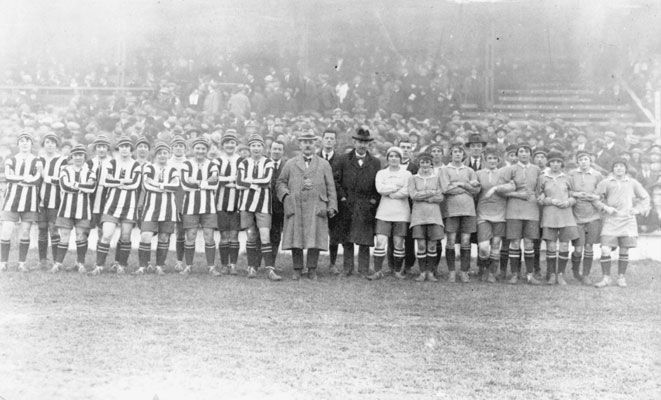From Banned to Beloved: Women's Football History and Wales' Euro Dream
- mattskinneruk
- Aug 7
- 4 min read
The aftermath of World War II ushered in a new era of change across the globe, and women's football was no exception. As societies began to rebuild and redefine gender roles, women's participation in football moved from the margins toward mainstream recognition. This pivotal period laid the foundations for the modern women's game we celebrate today, including landmark moments like Wales's long-awaited qualification for UEFA Women's Euro 2025 in Switzerland.
In this post, we explore the post-war rebirth of women's football: the setbacks, breakthroughs, and legacies that continue to shape the sport, culminating in Cymru's history-making moment.
⚽ The Pre-War Glory and the Ban That Silenced It
In the early 20th century, women's football flourished, especially during World War I, when men were away fighting. Matches drew tens of thousands of spectators. The iconic Dick, Kerr Ladies, formed by women working in a munitions factory in Preston, drew 53,000 fans to Goodison Park in 1920—a record for a women's match in England that stood for nearly a century.

But in 1921, the Football Association (FA) abruptly banned women from playing on affiliated pitches, claiming the sport was "unsuitable for females." This patriarchal ruling stifled growth and banished women's football to the sidelines for the next 50 years.
🔧 The Wartime Revival: Munitionettes and Morale
World War II, however, reignited the flame. As women stepped into wartime industries, many formed factory teams—particularly in munitions plants—offering both a morale boost and a statement of capability. The "Munitionettes" era was informal but symbolically powerful.

The Dick, Kerr Ladies continued to tour, play, and inspire, defying restrictions and demonstrating the demand for the women's game. Their legacy would eventually prove too strong to ignore.
🔓 Breaking the Ban: 1971 and the Road to Redemption
In 1971, 50 years after the ban, the FA finally lifted restrictions on women's football. That same year, the first official women's league in England was established, and international teams began to emerge across Europe and beyond.
Meanwhile, FIFA still lagged. Though the first unofficial Women's World Cup took place in Switzerland in 1955, it wasn't until 1991 that FIFA sanctioned a women's world tournament.
🚀 Growth and Globalisation: The 1980s to the Present Day
Throughout the 1980s and 1990s, the women's game began its climb toward legitimacy:
1984: UEFA held its first official European Competition for Women's Football.
1991: FIFA hosted the inaugural Women's World Cup in China.
1996: Women's football debuted at the Olympics in Atlanta.
Stars like Mia Hamm, Birgit Prinz, Sun Wen, and Marta became global icons. Nations like the USA, Germany, Brazil, and Japan developed professional leagues and made significant investments. Stadiums filled, sponsors noticed, and millions of girls worldwide now grew up with idols who looked like them.
🏴 Cymru Rises: The Legacy Comes Full Circle in 2025
The post-war perseverance of women's football paved the way for history to be made in December 2024, when the Wales women's national team qualified for their first-ever major tournament: UEFA Women's Euro 2025 in Switzerland.
Their path was every bit as dramatic and determined as those who came before:
Rhian Wilkinson, appointed head coach in early 2024, brought tactical clarity and belief to the squad.
Ceri Holland scored a stunning last-minute winner in extra time to beat Slovakia.
They defeated the Republic of Ireland in the play-offs to secure their place on the biggest stage in European football.
Jess Fishlock, Wales's most capped player, scored Wales's first-ever major tournament goal, cementing her legendary status and linking generations past with the present.

Their qualification represents more than sporting success—it's a triumph of persistence, culture, and equality. From playing in factory yards during wartime to standing proudly on Europe's grandest stage, the journey of women's football has come full circle.
💬 Women's Football History: A Legacy That Inspires the Future
Women's football in the post-WWII era is a story of resilience. Despite bans, prejudice, and neglect, generations of players persisted—often without recognition or reward. Their struggle gave rise to a new era where women can now shine on equal footing.
As Wales steps onto the pitch at Euro 2025, they carry with them the spirit of every girl who was once told, "Football's not for you." They represent every player who defied expectations, from the Munitionettes to the modern Red Wall.
And they remind us all: the right to play is always worth fighting for.
✅ Key Moments in the Journey of Women's Football
1921 – FA bans women's football
1940s – Wartime factory teams revive the game
1971 – Ban lifted; FA recognises women's football
1991 – First official FIFA Women's World Cup
2025 – Wales qualifies for its first major tournament







Comments